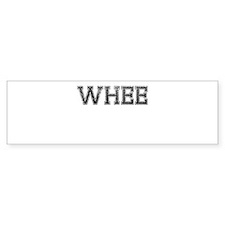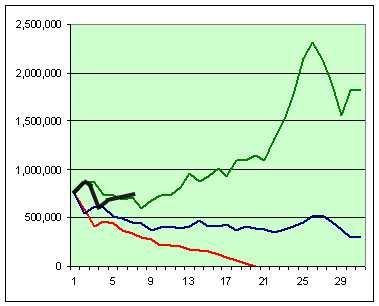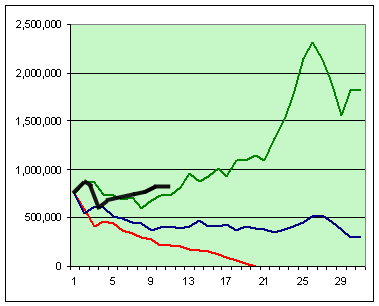CaliforniaMan, I'm curious...Are you withdrawing 3% because that is all you comfortably need at this point, or are you holding back on spending money on things you would really enjoy because you don't want to bump up your WR to 4%?
There are two answers, first I will give the (relatively) logical one, then the (more) real one.
I found that the 3% along with SS would give us about the same monthly income we have actually been spending for about the past year prior to retirement. We were frugal, but not overly miserly during that year and I thought we could also save some additional spending, by getting rid of some unnecessary expenses, like overpaying for insurance, cable, etc. In addition outgo will decrease due to paying less taxes (I pay self employment tax, ugh) and no savings set aside for retirement. We might spend a bit more in travel but can probably squeeze that in. Also my DW is younger than me and want to make sure it lasts. 3% will pretty much last forever with 70/30 under most circumstances.
The 4% or 4.5% I had originally planned would give us some more spending, and allow a little extravagance, but on the other hand, if I had that money I would probably spend it. I don't know about others, but if in my mind I don't have a budget, and I think I have extra spending money for that month, I will likely spend it. Go into Costco for example, and come out with a bunch of DVDs that after I get home realize that nobody really wants to watch, or furniture we don't have room for, or gadgets we will never use, or who knows what (those guys are geniuses in knowing how to get me to part with my money). My DW has some of the same issues, different stores, same problem. But when we are on a budget we do fine, and I do want to train us to learn how to better live on a budget now that I wont be able to plan on extra income.
Now for the real reason. I have been saving in my retirement accounts all my life. Through hard times and good, never even thinking about taking anything out during the hard times, never selling in down markets, other than putting money in, never thinking about the taking out part. It was hard fought income, and now that I am retired, I can't and don't want to fight that fight again, ever. I even have a hard time thinking about taking out the 3%. I will get some residuals (unpredictable amounts) over the next few years, and rather than spend them, will take them as income and decrease my retirement draw by the same amount.
It is a psychological problem for me. I am new to this retirement draw thing and it is more than a little bit scary. I know we only live so long, and want to have a good time during the remainder, not live the life of some foolish miser. On the other hand I could easily be a miser or be a spendthrift, and sometimes that middle road between those two is the hardest one to follow.
This is why your post in particular and this forum in general has been so helpful to me, and why I wanted to give a detailed response to your question. I am thoroughly enjoying my first month and a half of retirement so far, and this forum has been very helpful to me during the past year in changing my perspectives. I hope that over the coming years that middle road will become clearer and easier to follow.



